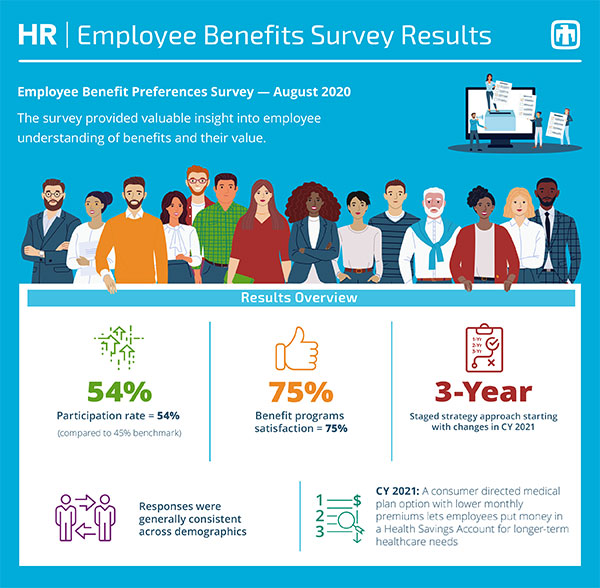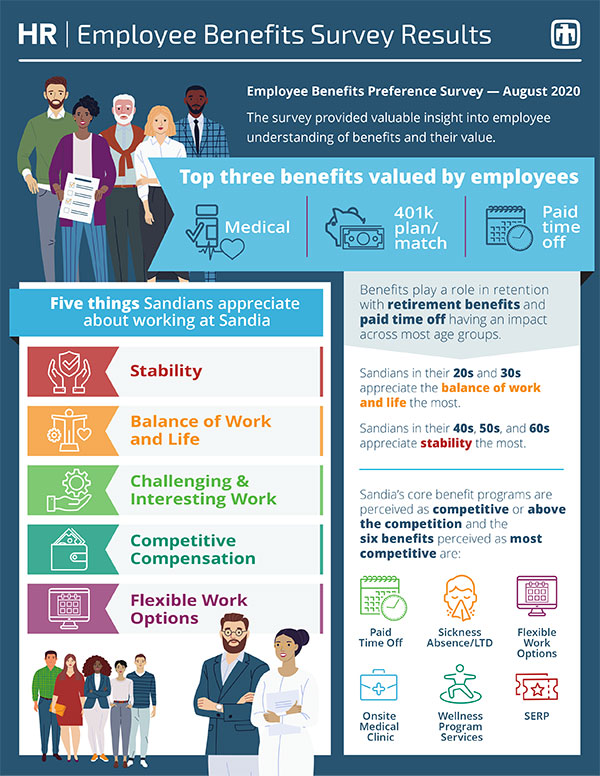
Benefits are important to Sandians, and feedback from the August Benefits Preference Survey provided insight into what employees value most, said Mary Romero Hart, senior manager.
Human Resources is using the results to continue to improve Sandia Total Rewards — the package of health and wellness, retirement savings, voluntary benefits, time away from work and work/life programs — to align with employee preferences.
With a participation rate of 54%, compared to the 45-50% industry benchmark, the survey shed light on where preferences vary among different groups. A common thread was that, overall, Sandians like their benefits and give especially high marks to the on-site medical clinic, wellness programs, flexible work options, sickness absence and paid time off and the Sandia Employee Recreation Program.
Satisfaction with benefit programs is 75%, similar to the industry benchmark. The data also show that although there is no great difference across age groups, Sandians in their 20s and 30s appreciate the balance of work and life the most, while older staff appreciate job security the most.
While satisfaction is high, the survey also revealed opportunities to make short- and long-term improvements, such as a health program option with lower employee costs. HR has conducted an in-depth analysis of the survey results, which it is using to develop a strategic benefits roadmap for the next three years.
“Our focus is a staged process of adjustments so we can begin offering some improvements as soon as possible, based on what we heard through the survey,” Mary said. With that information in hand, work is underway to add an optional, consumer-directed, high-deductible medical plan with a lower monthly premium that lets employees set money aside in a Health Savings Account for longer-term healthcare needs. Pending the always required government approval of any changes to Sandia benefits, details about the option will be in Open Enrollment communications this fall.
Survey data also indicate HR can further build employee satisfaction through the Total Rewards programs. Potential areas for change, all of which also depend on government approval, include programs to help with student loan debt, vacation buy/sell options, and further extension of recognition strategies.
Total Rewards helps attract, retain people

The Total Rewards program, which evolves based on knowledge of employee needs and the market landscape, supports Sandia in reaching its full potential, Mary said. The goal is to find ways to attract and retain the right talent to execute Sandia’s mission, Mary said.
The survey and benefits planning roadmap tie directly to Sandia’s Strategic Priorities 6 and 7: ‘Deploy outstanding engineering, science, and technology to our mission’ and ‘Unleash the power of Sandia.’
“We know that traditional benefits no longer ensure a company’s competitive advantage. Employees are individuals and expect more unique, customized personal benefits where possible,” Mary said.
In fact, the survey revealed that 76% of Sandians indicate they want flexibility to choose benefits that best meet their needs.
The format of the Benefits Preference survey was different and more lengthy than the traditional ‘How satisfied are you?’ type of survey. Mary said Sandia gained much more insight from the dynamic survey format because it gave employees the opportunity not only to share their understanding and opinions of the value of Sandia’s benefits program, but also provided hypothetical trade-off decisions, similar to the way one might make decisions about other types of purchases. Aon, an independent consulting firm, conducted the survey on Sandia’s behalf and performed the initial analysis. Only collective results were reported to Sandia.
Mary said the survey analysis incorporates a robust scenario modeling tool that “enables data-driven approaches to guide planning more finely tuned to employees’ perspectives.
“The detail will help guide us in aligning benefits with what employees across the multigenerational workforce want,” she said.
She said that another survey insight was that when employees better understand their benefits and the complete package of available benefits, they have greater job satisfaction.
“The results also aided us in seeing some places where increased education and engagement with the workforce are needed,” she said. “We are looking at ways we can improve in this area to make sure employees have the best understanding of what is available to them and how to most effectively choose and make use of their benefit options.
“We genuinely appreciate the time and thought employees gave to this important survey and I want to say thank you to everyone who participated,” Mary said.